
The Local Group is the galaxy group that includes the Milky Way. It has a total diameter of roughly 3 megaparsecs (10 million light-years; 9×1019 kilometres), and a total mass of the order of 2×1012 solar masses (4×1042 kg). It consists of two collections of galaxies in a "dumbbell" shape; the Milky Way and its satellites form one lobe, and the Andromeda Galaxy and its satellites constitute the other. The two collections are separated by about 800 kiloparsecs (3×10^6 ly; 2×1019 km) and are moving toward one another with a velocity of 123 km/s. The group itself is a part of the larger Virgo Supercluster, which may be a part of the Laniakea Supercluster. The exact number of galaxies in the Local Group is unknown as some are occluded by the Milky Way; however, at least 80 members are known, most of which are dwarf galaxies.

The Sculptor Group is a loose group of galaxies visible near the south galactic pole. The group is one of the closest groups of galaxies to the Local Group; the distance to the center of the group from the Milky Way is approximately 3.9 Mpc (12.7 Mly).
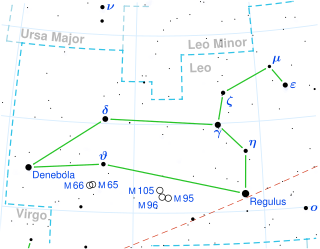
Regulus is the brightest object in the constellation Leo and one of the brightest stars in the night sky. It has the Bayer designation designated α Leonis, which is Latinized to Alpha Leonis, and abbreviated Alpha Leo or α Leo. Regulus appears singular, but is actually a quadruple star system composed of four stars that are organized into two pairs. The spectroscopic binary Regulus A consists of a blue-white main-sequence star and its companion, which has not yet been directly observed, but is probably a white dwarf. The system lies approximately 79 light years from the Sun.

A dwarf galaxy is a small galaxy composed of about 1000 up to several billion stars, as compared to the Milky Way's 200–400 billion stars. The Large Magellanic Cloud, which closely orbits the Milky Way and contains over 30 billion stars, is sometimes classified as a dwarf galaxy; others consider it a full-fledged galaxy. Dwarf galaxies' formation and activity are thought to be heavily influenced by interactions with larger galaxies. Astronomers identify numerous types of dwarf galaxies, based on their shape and composition.
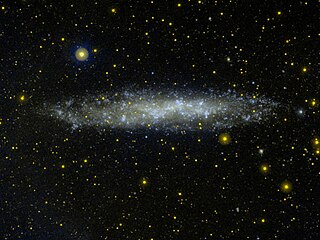
NGC 3109 is a small barred Magellanic type spiral or irregular galaxy around 4.34 Mly away in the direction of the constellation of Hydra. NGC 3109 is believed to be tidally interacting with the dwarf elliptical galaxy Antlia Dwarf. It was discovered by John Herschel on March 24, 1835 while he was in what is now South Africa.
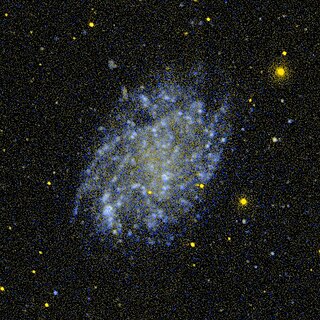
A low-surface-brightness galaxy, or LSB galaxy, is a diffuse galaxy with a surface brightness that, when viewed from Earth, is at least one magnitude lower than the ambient night sky.

Mu Cassiopeiae, Latinized from μ Cassiopeiae, is a binary star system in the constellation Cassiopeia. This system shares the name Marfak with Theta Cassiopeiae, and the name was from Al Marfik or Al Mirfaq (المرفق), meaning "the elbow". It is dimly visible to the naked eye as a point of light with an apparent visual magnitude of 5.16. The system is located at a distance of 24.6 light years from the Sun based on parallax, and is moving closer with a high radial velocity of −98 km/s. This star will move into the constellation Perseus around 5200 AD.

Sextans B is an irregular galaxy that may be part of the Local Group, or lie just beyond it. Sextans B is 4.44 million light-years away from Earth and thus is one of the most distant members of the Local Group, if it is indeed a member. It forms a pair with its neighbouring galaxy Sextans A. It is a type Ir IV–V galaxy according to the galaxy morphological classification scheme. Sextans B may also be gravitationally associated with the galaxies NGC 3109 and the Antlia Dwarf.

The Antlia Dwarf is a dwarf spheroidal/irregular galaxy. It lies about 1.3 Mpc from Earth in the constellation Antlia. It is the fourth and faintest member of the nearby Antlia-Sextans Group of galaxies. The galaxy contains stars of all ages, contains significant amounts of gas, and has experienced recent star formation. The Antlia Dwarf is believed to be tidally interacting with the small barred spiral galaxy NGC 3109.

NGC 2552 is a Magellanic spiral galaxy located some 22 million light years away. It can be found in constellation of Lynx. This is a type of unbarred dwarf galaxy, usually with a single spiral arm. It is inclined by 41° to the line of sight from the Earth along a position angle of 229°. The measured velocity dispersion of the stars in NGC 2552 is relatively low—a mere 19 ± 2 km/s. This galaxy forms part of a loose triplet that includes NGC 2541 and NGC 2500, which together belong to the NGC 2841 group.
Leo T is a dwarf galaxy situated in the Leo constellation and discovered in 2006 in the data obtained by Sloan Digital Sky Survey. The galaxy is located at the distance of about 420 kpc from the Sun and moves away from the Sun with the velocity of about 35 km/s. The velocity with respect to the Milky Way is around −60 km/s implying a slow infall onto the Milky Way. Leo T is classified as a transitional object between dwarf spheroidal galaxies (dSph) and dwarf irregular galaxies (dIrr). Its half-light radius is about 180 pc.

NGC 6503 is a field dwarf spiral galaxy located at the edge of a region of space called the Local Void. The dwarf galaxy spans 30,000 light-years and lies approximately 17 million light-years away in the constellation of Draco. The spiral galaxy is especially colorful where bright red regions of gas can be seen scattered through its spiral arms. Bright blue regions contain stars that are forming. Dark brown dust areas are in the galaxy's arms and center.

DDO 190 is a dwarf irregular galaxy in the vicinity of the Milky Way, as it is relatively small and lacks clear structure. It is 9.10 million light-years (2.79 Mpc) away from Earth and lies out of the Local Group, determined by the tip of the red giant branch method. The outskirts of the galaxy are harbouring older (reddish) stars, while the centre is crowded with younger (bluish) stars. Heated gas is observed at several places. DDO 190 still experiences some active star formation. The galaxy is categorised as a Magellanic dwarf galaxy of morphological type Im. Its metallicity is [Fe/H] = −1.55 ± 0.12.
EPIC 204278916 is a pre-main-sequence star, about five million years old with a spectral type of M1, implying a red dwarf. It is part of the Upper Scorpius sub-group of the Scorpius–Centaurus association, and is in the constellation Scorpius. The star is approximately the size of the Sun at 0.97 R☉, but is only half its mass (0.50 M☉) and a fraction of its luminosity (0.15 L☉).

NGC 4707 is an irregular galaxy in the constellation of Canes Venatici. It was discovered by John Herschel on 5 June 1834, and was described by John Louis Emil Dreyer, the compiler of the New General Catalogue, as a "small, stellar" galaxy.

NGC 5264, also known as DDO 242, is an irregular galaxy in the constellation Hydra. It is part of the M83 subgroup of the Centaurus A/M83 Group, located some 15 million light years away. The galaxy was discovered on 30 March 1835 by John Herschel, and it was described as "very faint, pretty large, round, very little brighter middle" by John Louis Emil Dreyer, the compiler of the New General Catalogue.

NGC 4242 is a spiral galaxy in the northern constellation of Canes Venatici. The galaxy is about 18 million light years away. It was discovered on 10 April 1788 by William Herschel, and it was described as "very faint, considerably large, irregular, round, very gradually brighter in the middle, resolvable" by John Louis Emil Dreyer, the compiler of the New General Catalogue.
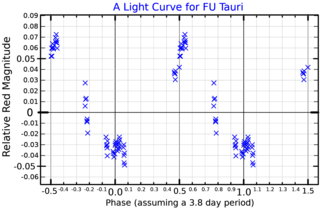
FU Tauri is a brown dwarf binary system in the constellation of Taurus about 429 light years away. The secondary is very close to the lower limit for brown dwarfs and several databases list it as a distant massive exoplanet.
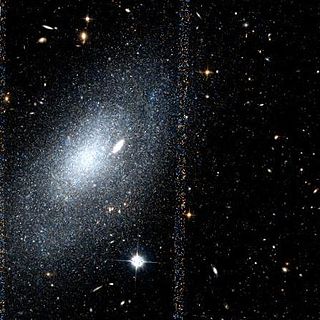
UGC 9405 is a faint dwarf irregular galaxy situated in the constellation of Ursa Major. It is about 20.5 million light-years, or 6.3 megaparsecs, away from the Earth. It is listed as a member of the M101 Group, a group containing the several galaxies orbiting the largest, Pinwheel Galaxy (M101). However, due to its far distance from the Pinwheel Galaxy, its membership of the group is uncertain.


















